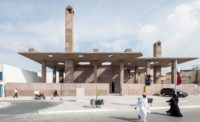Seattle, Washington
Owner: Vulcan, Inc.
Program: A three-level, 112,000-square-foot headquarters for the nonprofit global health organization PATH. Located in a five-story mixed-use building near downtown Seattle, the new headquarters offers nearly twice the space of PATH's old office, which it had outgrown. The project includes open-plan office space, conference rooms, small meeting rooms, a lab and shop for the organization's scientists and researchers, a library, a café, and several kitchenettes scattered over the three floors.
Design Concept and Solution: PATH's old headquarters tended to limit interaction among colleagues, with its emphasis on individual offices and its multiple floors, which felt closed off from one another. Charged with designing a new, larger space that would encourage employees to share knowledge and ideas, SkB Architects knew that simply setting up an open-plan office wouldn't have much effect on what was a rather solitary organizational culture. To set up the space in a way that would build interaction into normal routines, the architects treated necessities—office supply storage, kitchenettes, the café—as focal points rather than out-of-the-way secondary spaces, and decorated these utility areas to be inviting, almost domestic places. SkB connected the three floors with a central open stair; they treated each landing and its surroundings as a social hub dedicated to public meeting space, supplies, or food and drink. Each floor has one or two kitchenettes with textured, family-style furnishings (big oak tables, islands made from salvaged wood) and above-cabinet lighting that washes the ceilings and walls in soft, indirect light. To mitigate the repetitiveness that can take hold in large open-office plans with row upon row of workstations, the architects broke up the ceiling with floating acoustic planes and a mix of decorative hanging light fixtures. And they balanced the open space with a lot of glass-fronted work rooms for small groups and private use. These—like the rest of the office—are decorated almost as a collective living room, with tapestries, artwork, rugs, and crafts collected by PATH employees over their many years of travel to Africa, India, Malaysia, and other parts of the world. Texture was important to SkB's approach to the interiors: in addition to favoring old wood and PATH's own cache of vintage furnishings, they left the building's existing concrete raised floor system exposed, adding area rugs to soften the cool tones of the concrete.
Architect
SkB Architects
2333 Third Avenue
Seattle, WA 98121
Tel: (206) 903-0575
Fax: (206) 903-1586
Completion Date:
January 2010
Gross square footage:
102,000 Sq. Ft.
Construction cost:
Withheld at owner’s request
PeopleOwner: Vulcan, Inc. Architect: Personnel in architect's firm who should receive special credit: Architect of record: SkB Architects Interior designer: SkB Architects Engineer(s): Electrical: Sasco Electric Structural: Coughlin Porter Lundeen, Inc. Consultant(s) Acoustical: Sparling Project Management: The Seneca Group Laboratory: Jones Lang Lasalle LEED: GVA Kidder Matthews General contractor: Sellen Construction Company Photographer(s): Renderer(s): SkB Architects CAD system, project management, or other software used: Microstation V-8 |
ProductsWindows Glazing Insulated-panel or plastic glazing: Saflex (acoustic) Doors Metal doors: Curries, Steelcraft Wood doors: Washington Hardwoods Sliding doors: Washington Hardwoods Fire-control doors, security grilles: Cornell Special doors: Stiles Custom Metal, Inc. (Acoustic), Eliason (Shop) Operable Partitions: Hufcor Hardware Hinges: Stanley, Rixson Closers: Dorma, Corbin Russwin, Pemko Exit devices: Corbin Russwin, Ives Security devices: Architectural Control Systems, Inc, Alarm Lock Cabinet hardware: Hafele, Epco Interior finishes Suspension grid: Armstrong Cabinetwork and custom woodwork: Custom Interiors, ISEC (Lab) Paints and stains: Benjamin Moore, Scuffmaster Wall coverings: Philip Jeffries, Donghia, Maharam, Carnegie, Pollack, Koroseal, Wall Talkers Paneling: Custom Interiors Plastic laminate: Abet Laminati, Laminart, Formica, Oberflex, Nevamar Special surfacing: Pulp Studios, Richlite, Meyer|Wells Wood flooring: Admonter Resilient flooring: Mannington, Johnsonite Traffic flooring: Neogard Carpet: J&J | Invision, Constantine Raised flooring: Haworth - TecCrete Furnishings Reception furniture: Bright (seating), Crate & Barrel, West Elm, reclaimed antiques by PATH (side tables) Chairs: Herman Miller, Keilhauer (task), Andreu World, Thayer, Bright (side), Keilhauer, ISA, Acerey, McGuire (lounge) Tables: Gibraltar (conference), Andreu World (café), Room & Board, reclaimed antiques by PATH (side tables) Upholstery: Maharam, DesignTex, Schumacher, Brentano, S. Harris Lighting Downlights: Cooper, Ledalite, Focal Point, Pinnacle, Spectrum Task lighting: Allsteel Plumbing Add any additional building components or special equipment that made a significant contribution to this project: |











